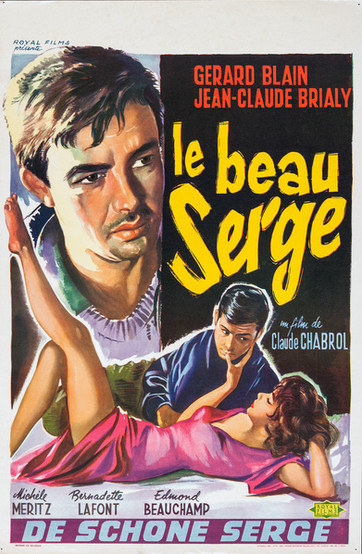I'll aim to keep my reviews of these three films brief and without revealing too many details of plot and focus instead on how they can be considered as an overview representative of the common themes and style of the French New Wave, even if they are perhaps less well-known.
Stylistically, Claude Chabrol's typically dark 1958 film "Le Beau Serge" (Eng: "Handsome Serge"), is the most conventional in purely cinematic terms, but then it suits the plot about a man who returns from the city to the village of his birth (a recurrent theme in post-war European cinema reflected in films like Lina Wertmuller's "The Basilisks" and earlier, in Fellini's "I Vitelloni") in order to reconnect with his dear childhood friend, the "Serge" (Gérard Blain) of the title.
Jean-Claude Brialy plays the man, "François Bayon", who discovers that in his absence, Serge has descended into alcoholism and is abusive to his long-suffering pregnant wife. The couple live in a crumbling farmhouse as Serge scrapes a meager living as a lorry driver travelling from village to village when he isn't frequenting the local tavern and drinking himself to oblivion.
Swayed by Serge's wretched state, François decides to stay put in the village for a while in order to save his friend and through the course of the film the details of his friend's life gradually come to light.
A third character in the form of "Marie" (Bernadette Lafont) who is Serge's sister though it is implied that she is his on-off lover even though she is barely past teen age, is introduced as a kind of village temptress who wastes no time in trying, and succeeding, in seducing the older François. The two embark on an affair which soon comes to the attention of Serge's drinking companion, "Glomaud", an abusive elderly drunk who has taken the role of being the adoptive father of Marie, or is her biological father, we are never quite sure.
Typically, as a Chabrol film, this is no mere social document about the differences between city and village life and any economic disparity that might exist. Subjects such as incest and paedophilia are unflinchingly scrutinised as a cause for both Serge's and Marie's psychological make up.
Serge's first child had died stillborn and possibly disabled and he is filled with guilt and disgust that he directs at his wife, and unable to face a future of hardship and poverty in a village he knows he will never escape from, by comparison with his old friend François, who has benefitted from education and found work in the city.
Marie has lived with Glomaud as his carer but it emerges that he has been waiting until she has reached the age of 18 and secretly covets her. When he discovers that she has been having an affair with François, he rapes her in a fit of jealousy, though it is clear that Marie's promiscuity is the result of some kind of sexual abuse, either from Glomaud or other men in the village.
Redemption for Serge comes in the form of the child born to his wife at the film's conclusion, who the village doctor declares is healthy and normal, and he rediscovers his zest for living after being saved by François before almost freezing to death in a barn in the middle of winter following a drinking binge.
Shot in monochrome during a bleak winter in rural France that underscores the tone of the film, Chabrol teases out a tale of horror that nonetheless ends on a positive note as Serge finds new meaning in his life and Marie is finally free from the clutches of Glomaud after he dies following a beating by François, who ultimately decides to stay on rather than return to his job in the city.
This bleak tone continues in Louis Malle's 1963 film "The Fire Within", in which Maurice Ronet's remarkable performance as the nihilistic former libertine in rehab, "Alain Leroy", carries the plot about Leroys' final farewell tour of all his old friends and acquaintances before deciding to end it all.
Ronet is reunited with his co-star from Malle's earlier "Jules et Jim" and "Elevator To The Gallows", Jeanne Moreau, playing an ex-girlfriend who has taken up with poets and drug addicts in a crumbling Parisian mansion while working at an art gallery, a detail that reinforces the sense that Leroys' milieu is the upwardly and downwardly mobile middle classes, ie people with choices but perhaps devoid of introspection, and it is Leroy's journey into his dark soul as he reflects wearily on his own profligate life and that of his circle of friends that leads to the films' shattering conclusion.
On the face of it, Agnes Varda's 1965 film, "Le Bonheur" (Eng: "Happiness") is a celebration of the joys of a settled rural family life in a sultry midsummer French provincial town, though it is anything but that.
It's been described as a horror film because of the way in which Varda delivers a feminist message without you ever really being aware of it and without taking an obvious position, in the tale of a handsome, happily married carpenter, "François" who embarks on an affair with a pretty post-office worker.
Varda lingers on scenes of familial bliss in the home and on forest picnics as François (Jean-Claude Drouot) and his wife "Therese", a dressmaker, (played by Drouot's real-life wife) and children, enjoy languid breaks.
As a man, François believes that it is his duty to spread joy and happiness and though he loves Therese and his children, he wants it all, and that includes allowing himself the freedom to fall in love with whoever takes his eye, hopefully with the acceptance of his wife even if his infidelity begins to trouble his conscience.
Marie-France Boyer plays the role of "Émilie Savignard", the postal worker whose flirting with the handsome François is reciprocated and who is a single, independent young woman who has no qualms about falling in love with a married man.
The fact that François fails to take into account his own wife's happiness proves to be his undoing, with tragic circumstances, and Varda ends the film in a way that is as disturbing as it is unambiguous in highlighting François' - or Émilie's for that matter - lack of self-awareness or introspection in matters of morality.
Shot in stunning colour at the height of summer, Varda employs an experimental approach to editing that is echoed in Louis Malle's "The Fire Within" to provide some insight into the drives of the main characters, and the art direction anticipates the bold use of colour in her husband Jacques Demy's film, "The Umbrellas of Cherbourg", to striking effect and which is carried through into transitions between scenes where the usual optical fade to black is replaced by floods of intense colour.
The film has a fair amount of nudity of the bare breasted variety in the love scenes between
François, Therese and Émilie that resulted in an adult certification for film on its' release, but these aren't especially shocking and they serve the same purpose as the picnic scenes or of happy family life, as representative of an idyll that is also reflected in the classical music score, before Varda, with characteristic deftness, delivers the hammer blow at the film's conclusion.

Agnes Varda's angle on her story about the freedoms enjoyed by men, told with more than a hint of irony, may have been informed by her own experience as a single mother but manages to downplay any sense of fury or outrage, instead opting for a slowly seductive approach that builds to a sense of unease as the story plays out and summer ends giving way to a golden autumn - as far as nature is concerned, nothing has occurred, but the human drama tells a different story.
"Le Beau Serge", Dir: Claude Chabrol, 1958
"The Fire Within", Dir: Louis Malle, 1963
"Le Bonheur", Dir: Agnès Varda, 1965
Criterion Channel




















Comments